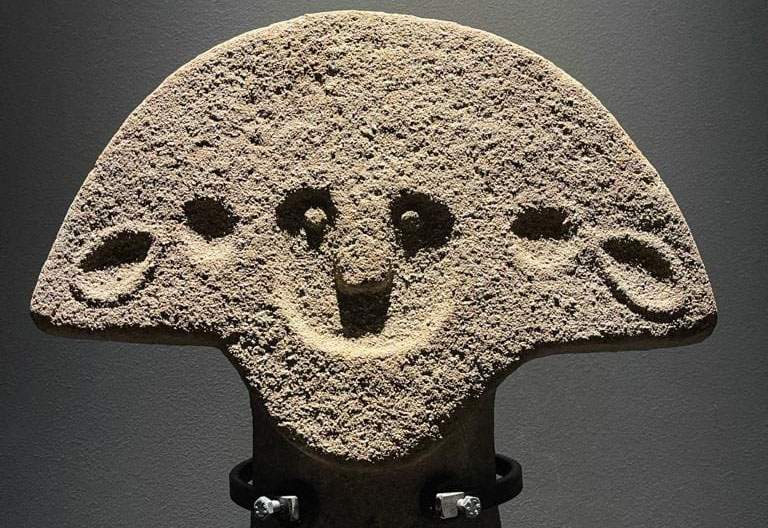The magnificent head of a stele statue found last March in a field on Mount Galletto near Pontremoli now becomes part of the permanent exhibition of the Museo delle Statue Stele Lunigianesi at the Castello del Piagnaro, the Lunigiana town’s institute that displays these ancient artifacts, symbols of the Ligurian Apuani who inhabited these lands several millennia ago. This was an exceptional discovery: stelae statues are in fact extremely rare artifacts (at the moment about 80 are preserved, most of which are in the very Museum of Stele Statues, the only museum dedicated to these sacred objects) and finding one, and moreover in such good condition, is not an everyday matter.
The head in question, a female head, dates back to the Copper Age (about 5,000 years ago), according to museum director Angelo Ghiretti. It has the classic half-moon shape typical of the statues of group “B” (one of the three groups into which the stelae are divided: those with the crescent-shaped head detached from the torso are, precisely, the statues of group B), and the stylized earrings she wears near her eyes unquestionably reveal her gender.
The head, which entered the catalog of stelae statues under the name “Pontremoli Monte Galletto 85” (each stelae statue is named after the site where it was found), is an authentic piece because, as the Pontremoli museum experts found, details of workmanship were found on the surface of the piece that could not be reproduced by a contemporary craftsman: in particular, the head shows obvious signs of wear resulting from the use of the technique of bushhammering with tenacious pebbles. This was the method of workmanship by which stelae statues were made, which were not produced with metal tools but with very hard and resistant stones, which left marks on the surface that would later wear away due to the multi-millennial action of weathering. The surface of the head was then also found to have some nicks from plowing with plows and mechanical hoes (the head was found fortuitously in a plowed field).
The head went to enrich the collection of the Museum of Stele Statues, along with five other finds, on the occasion of the European Archaeology Days of June 18-19-20, organized in Italy by the Ministry of Culture - Directorate General for Museums: the six new finds, recovered or discovered in recent years, were presented to the public and scholars on Saturday, June 19, and as of the latter date they can be seen in the museum.
The Campoli stele and Caprio stele head, already in a condition of progressive deterioration due to weathering, were removed from the outdoor environment and integrated into the museum itinerary, and with the support of Rotary Club Lunigiana it was possible to replace the originals with identical outdoor casts. Again, the deposit of the Levanto stele head fragment, by ministerial decree dated March 30, 2021, was granted to the Museum of Lunigiana Stele Statues, which was willing to provide copies to both the Archaeological Museum of La Spezia, which displays originals and casts, and the Permanent Exhibition of Material Culture in Levanto. Along with the Levanto head will be exhibited, as mentioned, the last stele head found, the Pontremoli Monte Galletto, which, precisely with the Levanto head, indicates the geographical limits of distribution of the stele statues: the fragment from Levanto the maximum western limit, the Monte Galletto the northern one.
Again, at the end of the itinerary, the eighteenth-century gargoyle recently found at Piagnaro Castle and a singular sexed guardian fac iòn (the “faciòn,” i.e., “big face,” is an ancient apotropaic head typical of the folk art of Val di Vara and Val di Magra), recovered fifty years ago in the Rossano-Zeri valley, formerly the Germano Cavalli Collection, purchased and donated to the Museum by director Angelo Ghiretti. The facións’ connection with stelae, only indirectly, lies in the fact that when heads of stelae statues were found, they were sometimes reused on portals (Aulla-Calamazza) or in their immediate vicinity (Caprio) just as with the facións of the Lunigiana folk tradition.
Pictured is the Pontremoli Monte Galletto 85
 |
| Pontremoli, magnificent head found in March on display at Stele Statue Museum |
Warning: the translation into English of the original Italian article was created using automatic tools. We undertake to review all articles, but we do not guarantee the total absence of inaccuracies in the translation due to the program. You can find the original by clicking on the ITA button. If you find any mistake,please contact us.